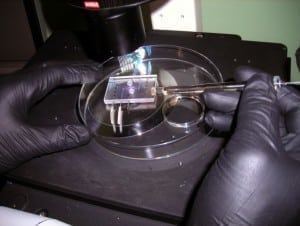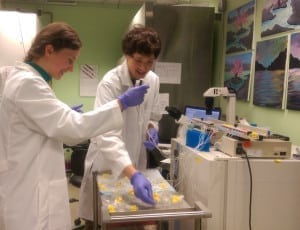
The U.S. Environmental Protection Agency will provide $6 million in seed funding for a Predictive Toxicology Center at the University of Washington, enabling researchers, including Department of Pharmaceutics Associate Professor Edward Kelly, to develop more accurate in vitro models – organ-mimicking cell cultures – to test chemicals for their potential risk to humans and to help accelerate the evaluation of large numbers of chemicals and reduce the need for animal models.
The center’s research is important to establish novel methods that reflect the complexity of biological systems. Elaine Faustman and Terrance Kavanaugh, both UW professors of environmental and occupational health sciences, will co-direct the new center. Kelly will manage the project on the kidney cell culture. “These systems are being used in our lab studies to test drugs with known adverse effects on the kidneys, including antibiotics, chemotherapies, and immunosuppressants,” he said. Kelly is involved in another research collaboration at the UW to get organ models like the intestines, liver, and kidney to work together.
Preliminary testing shows that the device works as a kidney would, expressing critical proteins and demonstrating the polarity characterized by the type of cells found in this organ. “The cells attach, proliferate, and form the same shape they would in a human body and thus replicate many of a kidney’s normal functions,” he said.

When these cells are exposed to a heavy metal, Kelly explained, a “toxicant signature” or biomarker of tissue injury is evident, such as an increased level of protein molecules expressed.
“These systems are being used in our lab studies to test drugs with known adverse effects on the kidneys, including antibiotics, chemotherapies, and immunosuppressants,” he said.
Kelly and Eaton are involved in another research collaboration at the UW to get organ models like the intestines, liver and kidney to work together. That work is funded by the National Institutes of Health. The new EPA-funded Predictive Toxicology Center will build on this work and apply these organ models to assess environmentally relevant chemicals.
After validating these three-dimensional cell cultures using known toxicants, the Predictive Toxicology Center researchers will investigate biomarkers of cell injury or altered function that indicate an adverse outcome from an exposure to those chemicals for which insufficient data exists.
They will then use modeling techniques to assess and predict human health risks, linking laboratory data with human exposure pathways.
The center will use computational models to identify and characterize adverse outcomes from environmental chemicals, focusing on the importance of time of exposure, genetics and oxidative stress as mediators of toxicity. Such an approach will allow for connecting in vitromodel results with human physiological changes and better predict a chemical’s potential for human health effects.
Read more about in Health Science NewsBeat